Scales
A good scale is one of the most basic and essential reloading tools. Normally used to set and check powder charges, it will also prove invaluable for checking bullet weights, sorting cases by weight, verifying case volume (by water capacity), etc..
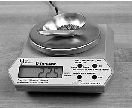
Digital electronic scales have become quite popular in the last few years, due to their faster operating speed.
Traditionally, balance beam scales have been the mainstay of handloaders. Within the last few years, however, electronic scales have become commonplace. With either type, the scale must be accurate to within one tenth (0.1) of a grain to be adequate for most reloading operations.
Most of the common electronic and balance beam scales are capable of approximately the same degree of accuracy. The primary difference in the two types is speed. Although almost all of the balance beam scales on the market today utilize some form of dampening system (magnetic, liquid, etc.), the electronic scales settle much faster. Speed becomes a factor if there is a large amount of scale work to be done, such as sorting cases by weight. In general, balance beam scales are less expensive than the electronic models. If price is a major consideration, this may be a deciding factor, but either type should give years of trouble free service.
Regardless of the type used, the scale must be “zeroed” before each use. Please follow the manufacturer’s instructions for the particular model in question. With either a balance beam or electronic scale, an accurate set of check weights should be used occasionally, to verify the scale’s accuracy. Reloading scales are sensitive enough to be affected by

A good quality scale is an essential tool for any reloader. This balance beam model is from Redding Reloading.
nearly imperceptible drafts, and should be located in a spot where they will not be subjected to breezes or air currents caused by air conditioning or heating vents.
Powder Dribblers
When loading cases with weighed charges, some method of bringing the powder charge weight up to the desired level is required. This is the function of a powder dribbler. Also known as a powder trickler, this handy little device is normally used in conjunction with a powder measure. In operation, the powder measure is set to throw a charge a few tenths of a grain lighter than the desired charge weight. The powder dribbler is used to drop powder directly into the pan as it sits on a scale, a few kernels at a time. In this manner, the powder can be brought up to exactly the desired charge weight before being funneled into the primed case. Presently, both manual and electric dribblers are available. Either will make loading large quantities of ammunition with weighed charges easier.
Powder Funnels

A standard powder funnel (left) compared to one with a 6″ drop tube (right). Both of these models are available from Forster/Bonanza.
A powder funnel, as the name implies, is a small funnel used to drop powder from the scale pan into the case. Nearly all reloading equipment manufacturers sell funnels made specifically for this purpose. Generally, one funnel will work for all cases from .22 to .45 caliber. Special funnels for the diminutive .17 caliber cartridges are also available.
A drop tube is a specialized accessory used to load large charges into a case. They may be found as either a conventional powder funnel modified by the addition of a long tube, or as a long accessory tube attached to a powder measure. The long drop allows the powder kernels to settle into the case very compactly. This will frequently allow a significantly greater amount of powder to be loaded than could be charged into the case with a standard funnel alone. It is worth noting that the length of the drop tubehas a definite effect on how much powder can be crammed into a case. Long drop tubes tend to settle the powder into the case more efficiently than do shorter tubes. Drop tubes are available through Bonanza, as well as several other manufacturers.
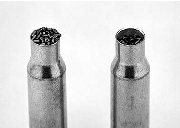
These two .308 Winchester cases contain exactly the same amount of powder and have the same internal capacity. The case on the right was filled using a 6″ drop tube, while the case on the left was filled using a conventional powder funnel. A drop tube settles the powder more compactly, allowing a greater amount to be loaded into a given case.
Powder Measures
A powder measure may not be an essential reloading tool, but if large quantities of ammunition are to be loaded, a good measure is a worthwhile accessory. As opposed to a scale, a measure dumps a preset charge of powder by volume. Depending on the handloader’s preference, these charges may then be weighed individually, or thrown directly into the case.
Adjustable measures, such as the RCBS Uniflow, Lyman 55, and Lee Perfect Powder Measure, are probably the most commonly used today. All operate on the same principle, using an adjustable powder chamber that can be set to throw the desired charge weight of a given powder. To adapt to both rifle and handgun reloading, most measures use interchangeable drums to accommodate the large discrepancy between pistol charges or magnum rifle loads within the same measure.
Pistol Measures
In addition to the more generic units, several makers produce measures designed specifically for dispensing pistol loads. The RCBS “Little Dandy” is an excellent example. Utilizing small, interchangeable rotors to adjust charge weights, these units are less expensive than many of the larger measures, but are still ideally suited to reloading the smaller charge weights common to pistol ammunition. Similar units are available from Lyman, Lee and Quinetics.
Benchrest Measures
Benchrest measures are not really a different type of measure per se, but are a much more refined version of the conventional powder measure. In brief, they can be defined by their greater precision and absolute repeatability. Most incorporate a baffle system in the powder reservoir to maintain a more consistent pressure on the powder being dropped into the measuring chamber. These measures generally utilize some form of micrometer or
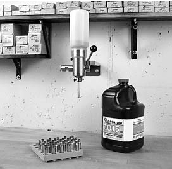
A correctly operated benchrest quality powder measure is capable of dispensing remarkably uniform charges. This superb unit is produced by Neil Jones Custom Products.
numbered adjustment on the powder drum, allowing a positive setting to be “clicked” or locked into position, and reliably repeated at the next reloading session. Most of the true benchrest powder measures on the market today are either limited production items, such as the superb units available from Neil Jones Custom Products, or custom conversions of conventional powder measures. The Lyman 55, SAECO, and Belding & Mull measures have been favorites for these conversions for many years.
Among “factory” measures, Redding offers their Model BR-30, which is highly thought of by many competitive shooters. Designed for powder charges of approximately 30 grains, the BR-30 offers a capacity range of 10 to 50 grains. This makes it unsuitable to many pistol cartridges and some of the larger rifle cartridges, a characteristic it shares with most of the custom units as well. It is, however, ideally suited to the cartridges that are being used in benchrest competition, such as the 6mm PPC and 6mm BR Remington. This type of limitation must be considered before buying such a specialized measure. Naturally, the benchrest grade measures are quite a bit more expensive than the conventional units, but if absolute precision and repeatability are necessary, they are well worth the money. Concentricity Gauges
As shooters have become more demanding in their search for accuracy, specialized reloading equipment has become much more commonplace. It is well known that bullet run-out, or concentricity, is a major factor in producing accu-rate ammunition. In years past, the accepted practice for checking concentricity of a handloaded round was to roll the cartridge across a flat surface, such as glass, and note any wobble at the bullet’s tip. This approach will allow for fast culling of obviously defective cartridges, but will fail to isolate those with less obvious run-out problems. Add to this the fact that run-out problems can be caused by not just an improperly seated bullet, but by the case itself, and the limitations of this approach become unacceptable.
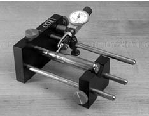
A NECO gauge is used to check the concentricity of a loaded cartridge. In addition to bullet run-out, the NECO gauge can be used to check a number of points along a case, such as wall thickness variation, neck and body concentricity, and the squareness of the case head.
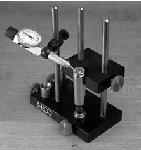
A NECO gauge can also check case head squareness.
Today, handloaders have several options that are capable of measuring concentricity to .001″ or less. Most operate on some variation of the same principle. A loaded cartridge is mounted in the unit, normally supported by a “V” block arrangement at the case head and bullet ogive. The cartridge is rotated slowly, while a dial indicator bears on the area of the cartridge being checked. Any concentricity problems are not only immediately visible, but measurable on the dial indicator.
One of the first commercial models, which is still readily available and quite popular, was the Forster/Bonanza Co-Ax Indicator. Recent entries in the concentricity gauge market include models by Sinclair International, NECO and RCBS. Some models, such as the NECO Gauge and RCBS Case Master, are capable of not only measuring bullet run-out, but case neck variation, wall thickness and concentricity as well. Given the accuracy obtainable, particularly from many of today’s bolt action rifles, using a concentricity gauge to get the last bit of accuracy out of handloaded ammunition makes perfect sense.
Bullet Pullers
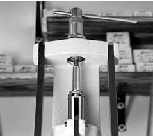
A collet type bullet puller in use. With the collet firmly gripping the bullet, lowering the ram will pull the case down and off the bullet.
A bullet puller is an item that is infrequently used, but should be on every reloader’s bench. A bullet puller is exactly what it sounds like; a tool used to extract a bullet from a loaded cartridge. It is not uncommon for a handloader to produce a quantity of ammunition that is unsatisfactory for one reason or another. The easiest way to dispose of such ammunition is to shoot it during a plinking session, assuming that the ammunition is safe to shoot. If there is a pressure problem, or any other safety concern that would preclude shooting it, the ammunition must be broken down into its component parts. This is the purpose of a bullet puller. There are several different types, but all perform exactly the same task.
Resembling a plastic mallet, inertia bullet pullers are one of the most widely used styles available today. The head of an inertia bullet puller is hollow, and equipped with a collet to hold the cartridge to be broken down centered within the bullet puller’s head. With the cartridge locked in place, the puller is given a sharp rap against a non-resilient surface such as concrete. The inertia of the bullet will pull it from the case mouth. The bullets are not usually damaged during this operation, and all salvaged components can be reused. Since the collet shell holders in inertia bullet pullers are normally universal, one puller can be used for virtually any size, caliber or type of centerfire cartridge.

A kinetic bullet puller is available from Dillon, RCBS, Quinetics and Midway.
Another popular model is the collet puller. Most brands have a die body threaded to fit a standard 7/8″x14 reloading press. Within this body is a collet correctly sized to grab the exposed portion of a bullet in a loaded cartridge. With the cartridge to be pulled placed in the shell holder of a standard reloading press, the ram is raised until the bullet has entered the collet of the bullet puller. The collet is then tightened on the bullet, and the ram is lowered. The leverage of the press easily pulls the case off the bullet, which stays tightly gripped in the collet. Like the inertia pullers, collet pullers do little or no damage to the bullet or case, and salvaged components can be reused. Collet bullet pullers are more expensive than the inertia pullers, especially since they will require a separate collet for every caliber bullet to be pulled.
The last variety of pullers are the spring steel units that are threaded into a standard reloading press. This is actually a slight variation on the collet puller. With a loaded cartridge placed into the shell holder, the ram is raised until the bullet pushes its way through the flexible spring steel jaws of the puller. Lowering the ram causes the jaws to grip the bullet even tighter, stripping it from the case mouth. The bullet remains firmly clenched in the jaws of the puller, until it is forced out by the next bullet to be pulled. This type of puller tends to mar the bullets quite badly, but it is a very fast way to breakdown ammunition. Like the collet pullers, these require that a different set of jaws be used for each caliber bullet to be pulled.
Despite the scratches left on the bullets pulled in this manner, they can still be reloaded for plinking or informal practice. When breaking down surplus military ammunition, regardless of which type of puller is used, bump the bullet a bit deeper in a seating die before attempting to pull it. This will break the asphalt sealant around the neck, making it much easier to extract the bullet.
Chronographs
Chronographs are a relatively recent innovation for the average reloader but have truly revolutionized handloading. Until about twenty years ago, chronographs were almost exclusively used by military and commercial ammunition manufacturers, being far too expensive and cumbersome for all but the most dedicated reloaders. Today, it is uncommon to go to the range and not find at least one shooter using a chronograph to evaluate his loads. Aside from the obvious advantage of determining the velocity of a given load, a chronograph can be invaluable in evaluating the consistency of reloaded ammunition. Extreme spreads in velocity, while not always obvious on short range targets, will greatly effect the long range accuracy potential of a load. With a little preliminary work, such chronograph data can save precious range time by weeding out loads that may give good results at 100 or 200 yards, but will show too much vertical dispersion at long range. For some shooting applications, access to a reliable chronograph is an absolute necessity.
Since its inception, IPSC/USPSA action pistol shooting has evolved to include different scoring categories for both “major” and “minor” cartridges. In order to make “major”, the power factor (bullet weight in grains multiplied by velocity in feet per second) must equal 165,000 or greater. A competitor who accepts the data as shown in a manual and goes to a match without verifying the load indeed makes “major,” may find himself competing at a disadvantage when his ammunition is chronographed at the match and falls into the “minor” scoring category. Even worse, a shooter’s ammunition could fail to make the minimum power floor, and would be disqualified from the match. Chronographs today have become inexpensive and easy to use, making their use at matches to check a competitor’s ammunition almost certain.
Unseen variables that may play an important role in load development can sometimes be detected through the use of a chronograph. Primer incompatibility, lot to lot variations of the “same” powder, differences between brands of brass, etc., will become readily apparent when velocity fluctuations can be recorded.
The earliest units available to handloaders were anything but convenient to use. Few provided direct readouts of velocity, with most giving a series of numbers that had to be “translated” into velocity by hand. This was generally accomplished by means of a manual, which contained conversion charts showing which velocity corresponded to which read out, and so on. The basis of most chronographs is a counter, or clock, which measures the time taken by a projectile to cover a specified distance. While most modern chronographs utilize photoelectric skyscreens to trigger this clock, many of the older units used paper screens containing a wire filament that had to be physically broken by the passage of a bullet. Naturally, these screens had to be replaced for each and every shot. The “shoot-through” construction of these screens prevented the shooter from firing for velocity and accuracy at the same time. In other words, you shot for groups, or you shot for velocity readings, but you couldn’t do both in the same string. In use, the photoelectric screen serves as an “eye” looking upwards. When a bullet is fired over these screens, they detect its passage by a change in the amount of light coming into the receptor, in effect “seeing” the shadow of the bullet. Today, shooters tend to take these photoelectric marvels for granted, a tribute to how efficient and easy to use they have become.
Most of these early units were quite crude by comparison to today’s compact, powerful and versatile chronographs. Where most of the older chronographs gave only velocity, some of the newer units will provide shot to shot reviews of every string, standard deviation, average velocity, extreme spreads, and high and low velocity readings from every string. The Oehler Model 43, more aptly titled as a Personal Ballistics Laboratory, is even capable of providing pressure readings from a conventional firearm, determining ballistic coefficient, and plotting group size via a downrange acoustical target.
